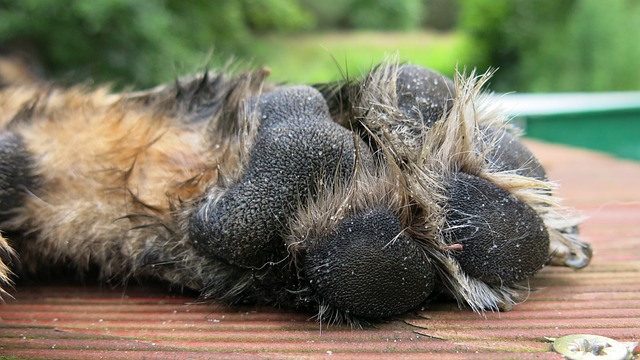Do German Shepherds Have Webbed Feet? (2024)
Hello there! Let’s talk about German Shepherds and webbed feet. Do German Shepherds have webbed feet? I don’t know about you, but this is an important question that should be answered, and that is what I am going to do today. Remember when we discussed the Great Danes and webbed feet? We provided a whole lot of information in that article, so you might want to check it out.
To start with, German Shepherds are one of the most popular and versatile dog breeds known for their intelligence, loyalty, and athleticism. As pet owners and enthusiasts explore the various aspects of this breed, questions often arise about their physical characteristics, including their paws. One such question is whether German Shepherds have webbed feet. In this article, we will delve into the topic and uncover the truth about German Shepherds and webbed feet.
What Are Webbed Feet?
Webbed feet refer to the anatomical feature found in certain animals that possess skin between their toes, creating a web-like structure. These specialized feet aid animals in various activities such as swimming, diving, and walking on soft surfaces. Aquatic animals, such as ducks and otters, are well-known examples of species with webbed feet.
Do German Shepherds Have Webbed Feet?
No, German Shepherds do not have webbed feet. The breed standard for German Shepherds does not include webbing between the toes. Their paw structure consists of well-defined, separate toes without any skin connecting them. German Shepherds’ paws are designed to provide traction, balance, and agility, which are essential for their roles as herding, working, and service dogs.
Why Do Some Dogs Have Webbed Feet?
Webbed feet are a genetic trait that is passed down from parents to offspring. The trait is thought to have evolved in dogs that were bred for water work, such as hunting or retrieving. Webbed feet can help dogs swim more efficiently and paddle more effectively.
The Anatomy of German Shepherd Paws
To understand why German Shepherds do not have webbed feet, it is essential to examine the anatomy of their paws.
- Paw pads: The paw pads are the thick, leathery cushions on the bottom of the paws. They are made of keratin, collagen, and fatty tissues, and they provide a number of important functions. The paw pads act as shock absorbers for the bones and joints in the feet, protecting them from injury. They also help to provide traction on slippery surfaces, and they help to regulate the dog’s body temperature.
- Digital pads: The digital pads are the small, fleshy pads that are located between the claws. They also help to provide traction and shock absorption, and they help to protect the claws.
- Metacarpal/metatarsal pads: The metacarpal/metatarsal pads are the large, fleshy pads that are located on the top of the paws. They help to provide support and stability to the paws, and they also help to protect the bones and joints in the feet.
- Claws: The claws are the sharp, pointed nails that are located on the ends of the toes. They help the dog grip and climb, and they can also be used for self-defense.
- Dewclaw: The dewclaw is a small, vestigial claw that is located on the inside of the front leg, just above the paw. Dewclaws are often removed from German Shepherds, as they can get caught on things and injure the dog.
Related articles
- how to prepare your home for a puppy
- Why Does My German Shepherd Whine? (5 Reasons Explained)
- How Cold Can a German Shepherd Tolerate?
- Do Electric Fences Work for German Shepherds?
The Function of Paws in German Shepherds
German Shepherds have paws that are well-suited to fulfill a variety of functions essential for their daily activities. From providing stability and traction to facilitating specific tasks, the paws of German Shepherds play a crucial role in their overall functionality. Let’s check out the functions of their paws in detail:
- Traction and Grip: German Shepherds’ paws are designed to offer excellent traction and grip on different surfaces. Their paw pads, composed of tough and durable skin, provide friction against the ground, enabling them to maintain stability while running, turning, or stopping abruptly. This traction is particularly important for their work in various terrains, such as herding on uneven surfaces or navigating challenging landscapes during search and rescue operations.
- Shock Absorption: The pads on the undersides of German Shepherds’ paws act as shock absorbers, cushioning the impact on their joints and bones while engaging in physically demanding activities. This feature helps reduce stress on their legs, contributing to their endurance and overall comfort during tasks that involve running, jumping, or landing.
- Protection: The pads on German Shepherds’ paws serve as a protective barrier between their feet and the ground. They provide insulation against extreme temperatures, shielding the paws from hot pavement or cold surfaces. Additionally, the pads help safeguard against rough terrain, sharp objects, and potential injuries.
- Digging and Scratching: German Shepherds possess strong and sturdy paws that allow them to dig and scratch the ground when necessary. This digging instinct can be useful in tasks such as search and rescue, where they may need to uncover or access hidden objects or individuals. Their paws’ structure enables them to efficiently excavate soil or manipulate their surroundings as required.
- Object Manipulation: German Shepherds’ paws are dexterous and agile, enabling them to manipulate objects with precision. Whether it’s picking up and carrying items during training exercises or assisting handlers by grabbing and retrieving specific objects, their paws provide the necessary coordination and control.
- Climbing and Grip: German Shepherds’ paw structure allows them to excel in climbing activities. With their strong claws and flexible toes, they can grip various surfaces, including trees, walls, or obstacles. This capability is particularly valuable in search and rescue scenarios where they may need to navigate through challenging environments or aid in accessing elevated locations.
- Balance and Stability: German Shepherds’ paws contribute significantly to their overall balance and stability. The individual toes and their independent movement allow for precise adjustments and weight distribution, ensuring the dogs maintain equilibrium on uneven or unstable surfaces. This balance is crucial for their performance in activities such as herding or obedience training, where quick changes in direction are required.
- Sensory Perception: German Shepherds’ paws are equipped with numerous nerve endings, providing them with sensory perception and feedback about their surroundings. This sensory information aids in their ability to assess the terrain, detect subtle vibrations, and make quick adjustments to their movements as needed.
Benefits of Webbed Feet for Dogs
In dog breeds that have webbed feet, this anatomical feature offers several benefits that aid them in specific activities, which include:
Enhanced Swimming Abilities
Webbed feet provide increased surface area, allowing dogs to generate more propulsion and navigate through water more efficiently. The webbing between their toes acts as a paddle, pushing water backward and propelling the dog forward. This feature is particularly advantageous for breeds that are natural swimmers or are frequently engaged in water-based activities.
Improved Water Retrieval
Dog breeds with webbed feet, such as the Labrador Retriever or the Chesapeake Bay Retriever, excel at retrieving objects from water. The webbing enables them to grasp and hold onto items like balls or waterfowl with greater ease. It aids in their ability to retrieve game during hunting or participate in water-based sports, such as dock diving or water rescue.
Increased Stability on Soft Surfaces
Webbed feet provide dogs with improved stability and balance when walking or running on soft or uneven terrain like mud, sand, or snow. The webbing helps distribute the dog’s weight more evenly, preventing them from sinking too deeply or losing their footing in challenging conditions.
Efficient Land-based Locomotion
While webbed feet are primarily associated with aquatic abilities, some breeds with webbed feet also enjoy benefits on land. The webbing can aid in traction and grip, making it easier for dogs to traverse rugged terrain or climb over obstacles. This advantage is particularly useful for breeds that engage in activities like hiking, tracking, or mountain rescues.
Natural Paddles for Movement
Dogs with webbed feet have natural paddles that make movements in water smoother and more controlled. The webbing reduces resistance against the water, allowing them to swim with less effort and maintain a steady pace. This advantage is especially valuable for breeds involved in water-based tasks, such as water rescue or retrieving game in aquatic environments.
Are Webbed Feet a Sign of Good Breeding?
No, webbed feet are not a sign of good breeding in German Shepherds. The American Kennel Club (AKC) breed standard does not mention webbed feet, and it is not considered a desirable trait in the breed.
Common Misconceptions About German Shepherds Webbed Feet
There are a couple of common misconceptions regarding German Shepherds and webbed feet that need clarification.
Confusion with Other Breeds
Sometimes, the misconception arises due to confusion with other breeds known for webbed feet, such as the Labrador Retriever or the Chesapeake Bay Retriever. It’s important to distinguish between different breeds and their distinct physical traits.
Misinterpretation of Paw Structure
Another misconception stems from misinterpreting the normal paw structure of German Shepherds. Due to the presence of dense fur between their toes, some observers might mistakenly assume the existence of webbing. However, upon closer examination, it becomes evident that there is no actual webbing present.
Frequently Asked Questions
What are some other breeds of dogs that have webbed feet?
Some other breeds of dogs that have webbed feet include:
- Labrador Retriever
- Newfoundland
- Chesapeake Bay Retriever
- Portuguese Water Dog
- American Water Spaniel
- Nova Scotia Duck-Tolling Retriever
- Curly-coated Retriever
- Chesapeake Bay Retriever
- Old English Sheepdog
How do I know if my German Shepherd has webbed feet?
If you are unsure whether or not your German Shepherd has webbed feet, you can check the skin between the toes. If there is a thin membrane of skin connecting the toes, then your dog may have a small amount of webbing.
Do webbed feet make a dog a better swimmer?
Webbed feet can help dogs swim more efficiently, but they do not guarantee that a dog will be a good swimmer. Other factors, such as the dog’s build and swimming ability, also play a role.
Are there any health risks associated with webbed feet?
There are no known health risks associated with webbed feet in dogs. However, some dogs with webbed feet may be more prone to developing infections between the toes.
Can I increase the webbing on my German Shepherd’s feet?
There is no way to increase the webbing on a dog’s feet. Webbing is a genetic trait that is passed down from parents to offspring.
Can I train my German Shepherd to swim?
Yes, with proper guidance and training, many German Shepherds can learn to swim. However, not all German Shepherds may enjoy swimming, so it’s important to consider their individual preferences and abilities.
Do webbed feet provide an advantage in land-based activities?
Webbed feet are advantageous, primarily in aquatic environments. In land-based activities, the absence of webbing allows German Shepherds to have better maneuverability, stability, and adaptability to different terrains.
Can German Shepherds participate in water sports?
German Shepherds can participate in certain water sports, but they are not specifically bred for aquatic activities. Other breeds, such as the Labrador Retriever or the Portuguese Water Dog, are more commonly associated with water sports.
I hope this article has answered the question, “Do German Shepherds have webbed feet?”. If you have any other questions, please feel free to ask.




